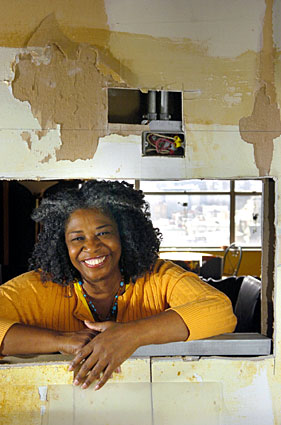Monday, December 24, 2007
How to flush a heating system
Consider flushing the system at least once a month during the heating season to keep things quietly moving. If you have a service contract through your utility company then it may be covered. If you are a hands on gal or guy then here’s
How to flush a heating system
1. Keep the service manual that came with the furnace handy
2. Open the air vents on all radiators located on the highest level of the house
3. Turn off the furnace’s power switch.
4. Shut off the furnace’s water supply
5. Let the furnace cool down
6. Attach a garden hose to the drain cock (faucet)at the lowest part of the boiler (usually at the rear) and lead the other end of the hose into a drain or bucket
7. Open the faucet. Let the line drain through the hose. (The water will be heavy and brown with rust and sediment)
8. When the flow slows, turn the water supply back on. Flush the boiler with fresh water. Do a few times.
9. When the water from the boiler runs clear, turn off the drain faucet.
10. Refill the boiler by opening the water supply until the furnace reaches its proper water level. The glass water-level indicator should be slightly more than half full
11. Turn boiler on
12. When you hear water filling the pipes, return to the top floor radiators and close the air vents. Open and close vents on all other radiators in the house to release any trapped air
Caution: You can crack the furnace by running cold water into a hot chamber so follow directions and take your time.
How to Bleed a Radiator
A home radiator that is cold at the top and warm at the bottom usually is a sign of trapped air. The radiator needs to be bled. Sounds like an episode of Dr. G, Medical Examiner. Here’s how to bleed a radiator for a steam and hot water system.
Steam system
1. Turn radiator off. Give it time to cool down if it is not already cold.
2. Unscrew radiator air vent (looks like a mini-silo with numbers on its head). Shake out any trapped water and replace it.
3. Place a small pan and rags on floor where radiator is connected to the steam pipe.
4. Use pipe wrench to loosen connector. Disconnect radiator from the steam pipe.
4. Tilt the radiator (You’ll need help. The radiator is heavy cast iron) and drain any trapped water into the pan.
5. Reconnect
6. Slide a shim under the radiator so it tilts toward the connection pipe. This allows proper drainage for the steam return.
Hot water system
1. Turn the furnace off
2. Look for the bleed valve at the top end of one side of the radiator
3. Using a “bleed key” turn the valve counter clockwise slowly about a half a turn
4. You’ll hear the hissing sound of air escaping as your turn the valve. When water begins to come out close the valve.
Extension Cord Safety

FIRE HAZARD: This extension cord is overloaded and laying right on a carpet.
Every time I see an extension cord I am reminded of a friend whose first home office was a TV snack table and a desktop computer with a power cord tautly stretched across the bedroom to the electrical outlet. I know he had to step high or do the limbo to keep from tripping over the cord. When the desktop became a laptop after the snack table collapsed under the weight, he repurposed the hall closet into now-you-see-it-now-you-don’t office space.
There being no electrical outlet in that closet and the nearest one about 15 feet away in the bedroom, he linked three of the shortest extension cords I’ve ever seen and stretched them across the room to power the computer, monitor, printer and desk lamp. Only two plugs would fit easily into the extension cords at one time so he went out and bought a really long fourth extension cord for the last available socket and plugged in the two remaining pieces of equipment.
The longer cord had reach but only two openings so he just went ahead and force fed the three-prong cord for the monitor into the two-prong extension cord. How he is not being remembered today in the past tense or at all is thanks to the blessings God bestows upon babies and fools.
Those jerry rigged hookups could have triggered a fire and nearly did if the hot to the touch cord with its burn marks and disfigured casing at the plug end of his cords were any indication.
I bring the subject up because extension cords are big this time of year. Many are being used by single mom home-based catering services that are plugging in extra cooking appliances to meet the demand for baked goods and full meals. Then there are the Christmas trees, holiday lights and ornaments twinkling away in and outside our homes. Carelessness with extension cords will produce a fire somewhere.
Not every extension cord is the right one for every job. There are heavy duty and light duty cords and those made for interior use and those for outdoor use. Interior cords are generally not insulated for use in wet weather. Plugging one extension cord into another also is risky since that reduces the current carrying capacity of the cord which could make it overheat, cause a fire and or damage the appliance that is plugged in. To find out what extension cord you need read and match the UL ratings and usage labels attached to the cord and the appliance it is powering.
“Electrical fires in our homes claim the lives of 485 Americans each year and injure 2,305 more. Some of these fires are caused by electrical system failures and appliance defects, but many more are caused by the misuse and poor maintenance of electrical appliances, incorrectly installed wiring, and overloaded circuits and extension cords.” That language comes straight from the Department of Homeland Security's Federal Emergency Management Agency’s Fire Administration. Words to the wise.
Quick safety tips for extension cords
- Don’t force a three prong plug into a two prong cord.
- Don't overload outlets with multiple plug-ins and adapters.
- Safeguard equipment from sudden power spikes and outages with a surge protector power strip.
- Avoid piggy backing by plugging in multiple extension cords.
- Choose the right extension cord. Length should not be the only criteria. Read the cord’s UL label for gauge, capacity, use and wattage rating.
- Use a rubber strip to cover any cords strung across a walk area to avoid tripping or damaging the cord.
- Got small, crawling, curious children around? Invest in safety power strip covers.
- When plugging in Christmas trees, raise up the connection between tree lights and the extension cord to keep it from resting on carpet, tree skirt or any potentially flammable surface.
- Make sure outlets are grounded. One with three holes suggests it is grounded but have an electrician check for certain.


